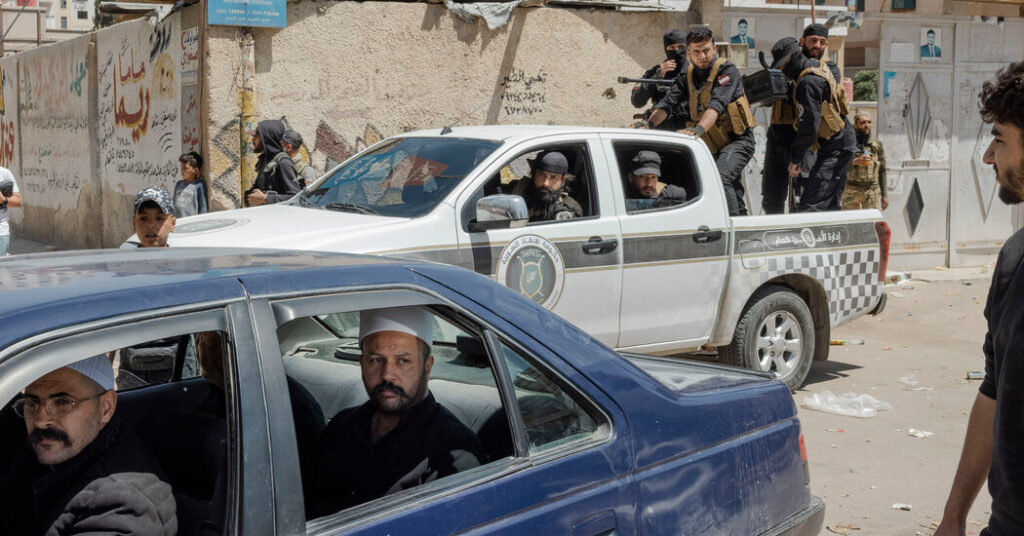Sirens blaring, a truckful of armed men trailing in its wake, the black sport utility vehicle that sliced sharklike through the Syrian town of Ashrafieh Sahnaya on Friday morning was impossible to miss.
Government forces had retaken control from the armed groups that turned the town into a sectarian battlefield for two days this week, killing dozens and exposing for all to see the new Syrian leaders’ shaky grip on security. Now, government representatives had arrived to pledge peace to a skeptical town.
In an airy, echoing religious meeting hall, two officials in suits sat shoulder to shoulder with white-bearded leaders of the Druse religious minority in traditional red-topped white hats, talking of unity.
“We’re all in one ship,” said Jameel Mudawwar, the area’s top official. “If it sinks, God forbid, we’ll all sink.”
The words were not new, but this time they came with action.
Syria’s main Druse militias, who control a strategic swath of southern Syria near Israel, have resisted a push by the new Islamist government to be folded into the national military, fearing that acceding would endanger their people.
But as the bloodshed mounted this week, local Druse leaders in Ashrafieh Sahnaya went the other way. In exchange for government concessions, including promises to investigate abuses committed during the clashes, they agreed to surrender their weapons and integrate some fighters into the government’s forces.
“We should love each other, and we should all stand with each other,” the town’s 86-year-old chief Druse religious leader, Sheikh Abu Rabih Haj Ali, said at Friday’s meeting. “We don’t want to carry weapons. We don’t want to be against the state.”
It was what the government had hoped to hear for months now, after rebels from Syria’s Sunni Muslim majority overthrew the dictatorship of Bashar al-Assad in December. But many Syrians from the country’s many religious and ethnic minorities remain wary of their new leaders amid repeated spasms of violence targeting minorities, including the Druse.
This week, a debunked audio clip purporting to be of a Druse cleric insulting the Prophet Muhammad incited Sunni extremists to attack Druse, including in Ashrafieh Sahnaya, south of Damascus, the capital. At least 101 people were killed, including government forces, Druse fighters and civilians, according to the Syrian Observatory for Human Rights, a Britain-based war monitor.
In Ashrafieh Sahnaya, where different sects have long coexisted peacefully, mortars and shells crashed into buildings. Drones struck from the sky, and residents cowered indoors as local Druse militia fighters battled government forces and armed Sunni extremists.
The rebel coalition that toppled Mr. al-Assad included some Islamist extremist factions that remain outside central control, and that the Syrian authorities have shown little capacity to rein in.
Israel, whose government is close to the Israeli Druse minority, then intervened in the name of protecting Syrian Druse, launching airstrikes on Syrian government targets.
There are more than one million Druse across the Middle East, mostly in Syria and Lebanon, and some in Jordan and Israel. They practice a secretive offshoot of Islam.
By Friday, the bloodshed still seemed more raw wound than memory for many.
One man at Friday’s meeting demanded government reassurances about security and safety. Dispensing with the conciliatory tone of the others present, he accused pro-government forces of slaughtering civilians.
The officials at the meeting pleaded for patience.
“We are promising you a better life,” said Mr. Mudawwar, the government official. “What happens to you will happen to us. It’s the government’s duty to protect everyone.”
Some listeners bought it.
Saleh Makiki, Mr. Haj Ali’s nephew, said he had lost five relatives this week, including his father, a son and an uncle. Yet he said he was willing to move forward.
“Mistakes happened, but we have assurances now,” he said. The government later released 32 local men detained during the clashes, satisfying a key Druse demand.
Outside the meeting hall, however, opinions were divided.
Across the street, Bahira Haj Ali, 42, leaned out her window to watch the sheikh, a relative, departing.
“It’s good we had the men to resist,” she said of the local Druse militias. “You can’t imagine the sounds we heard — shells, drones.” It was hard to trust government forces, she said, though, she added, she might feel different if men from Ashrafieh Sahnaya joined.
As for Druse militias’ weapons, Ms. Haj Ali said: “This is our security. It shouldn’t be given up.”
In town, there was disagreement over how the violence had begun.
Some Sunnis said that Druse militants had attacked government checkpoints after extremists attacked a nearby town, while some Druse said that Sunni extremists had struck first.
Around the town square, broken glass and bullet casings littered the ground. Dozens of young men marched into the square after Friday prayers ended at a nearby mosque, waving the flag of Hayat Tahrir al-Sham, the Sunni former rebel group that took power in December.
“One, one, one,” they chanted. “The Syrian people are one.”
But more often, it was their sect, not their country, that they emphasized.
“These are the Sunni,” they chanted. “The Prophet Muhammad is our eternal leader.”


